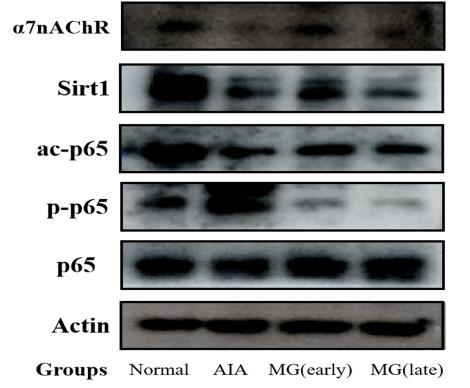Nicotinic Acetylcholine Receptor alpha 7 Antibody - #DF13247
| Product: | Nicotinic Acetylcholine Receptor alpha 7 Antibody |
| Catalog: | DF13247 |
| Description: | Rabbit polyclonal antibody to Nicotinic Acetylcholine Receptor alpha 7 |
| Application: | WB IHC IF/ICC |
| Cited expt.: | WB |
| Reactivity: | Human, Mouse, Rat |
| Prediction: | Chicken |
| Mol.Wt.: | 56kDa, 48 kDa; 56kD(Calculated). |
| Uniprot: | P36544 |
| RRID: | AB_2846266 |
Related Downloads
Protocols
Product Info
*The optimal dilutions should be determined by the end user. For optimal experimental results, antibody reuse is not recommended.
*Tips:
WB: For western blot detection of denatured protein samples. IHC: For immunohistochemical detection of paraffin sections (IHC-p) or frozen sections (IHC-f) of tissue samples. IF/ICC: For immunofluorescence detection of cell samples. ELISA(peptide): For ELISA detection of antigenic peptide.
Cite Format: Affinity Biosciences Cat# DF13247, RRID:AB_2846266.
Fold/Unfold
7nAChR; a7 nicotinic acetylcholine receptor; acetylcholine receptor, neuronal nicotinic, alpha-7 subunit; ACHA7_HUMAN; AChR; Acra7; alpha 7 neuronal nicotinic acetylcholine receptor; alpha-7 nicotinic cholinergic receptor subunit; alpha7; cholinergic receptor, neuronal nicotinic, alpha polypeptide 7; cholinergic receptor, nicotinic, alpha 7 (neuronal); cholinergic receptor, nicotinic, alpha 7; cholinergic receptor, nicotinic, alpha polypeptide 7; CHRNA7; CHRNA7-2; NACHRA7; neuronal acetylcholine receptor protein, alpha-7 chain; Neuronal acetylcholine receptor subunit alpha-7;
Immunogens
A synthesized peptide derived from human Nicotinic Acetylcholine Receptor alpha 7, corresponding to a region within N-terminal amino acids.
- P36544 ACHA7_HUMAN:
- Protein BLAST With
- NCBI/
- ExPASy/
- Uniprot
MRCSPGGVWLALAASLLHVSLQGEFQRKLYKELVKNYNPLERPVANDSQPLTVYFSLSLLQIMDVDEKNQVLTTNIWLQMSWTDHYLQWNVSEYPGVKTVRFPDGQIWKPDILLYNSADERFDATFHTNVLVNSSGHCQYLPPGIFKSSCYIDVRWFPFDVQHCKLKFGSWSYGGWSLDLQMQEADISGYIPNGEWDLVGIPGKRSERFYECCKEPYPDVTFTVTMRRRTLYYGLNLLIPCVLISALALLVFLLPADSGEKISLGITVLLSLTVFMLLVAEIMPATSDSVPLIAQYFASTMIIVGLSVVVTVIVLQYHHHDPDGGKMPKWTRVILLNWCAWFLRMKRPGEDKVRPACQHKQRRCSLASVEMSAVAPPPASNGNLLYIGFRGLDGVHCVPTPDSGVVCGRMACSPTHDEHLLHGGQPPEGDPDLAKILEEVRYIANRFRCQDESEAVCSEWKFAACVVDRLCLMAFSVFTIICTIGILMSAPNFVEAVSKDFA
Predictions
Score>80(red) has high confidence and is suggested to be used for WB detection. *The prediction model is mainly based on the alignment of immunogen sequences, the results are for reference only, not as the basis of quality assurance.
High(score>80) Medium(80>score>50) Low(score<50) No confidence
Research Backgrounds
After binding acetylcholine, the AChR responds by an extensive change in conformation that affects all subunits and leads to opening of an ion-conducting channel across the plasma membrane. The channel is blocked by alpha-bungarotoxin.
Cell junction>Synapse>Postsynaptic cell membrane>Multi-pass membrane protein. Cell membrane>Multi-pass membrane protein.
Belongs to the ligand-gated ion channel (TC 1.A.9) family. Acetylcholine receptor (TC 1.A.9.1) subfamily. Alpha-7/CHRNA7 sub-subfamily.
Research Fields
· Environmental Information Processing > Signal transduction > Calcium signaling pathway. (View pathway)
· Environmental Information Processing > Signaling molecules and interaction > Neuroactive ligand-receptor interaction.
· Human Diseases > Cancers: Overview > Chemical carcinogenesis.
· Organismal Systems > Nervous system > Cholinergic synapse.
References
Application: WB Species: Rat Sample: RAW264.7 Cells
Restrictive clause
Affinity Biosciences tests all products strictly. Citations are provided as a resource for additional applications that have not been validated by Affinity Biosciences. Please choose the appropriate format for each application and consult Materials and Methods sections for additional details about the use of any product in these publications.
For Research Use Only.
Not for use in diagnostic or therapeutic procedures. Not for resale. Not for distribution without written consent. Affinity Biosciences will not be held responsible for patent infringement or other violations that may occur with the use of our products. Affinity Biosciences, Affinity Biosciences Logo and all other trademarks are the property of Affinity Biosciences LTD.







